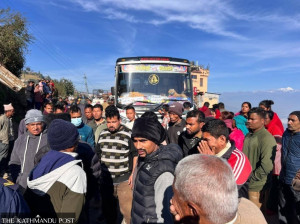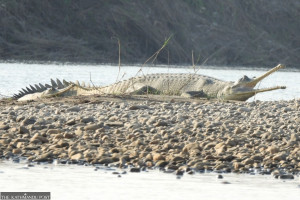Bagmati Province
Gharial found dead with trapped snout, punctured belly
Rampant use of fishing nets, human activities, river pollution and depletion in the number of fish are the major challenges to gharial conservation.
Ramesh Kumar Paudel
A male gharial—a critically endangered species of crocodile—was found dead in the Budhi Rapti stream at Ratnanagar Municipality-8 in Chitwan.
The Chitwan National Park (CNP) said the gharial was found dead in the stream that flows through the Baghmara Buffer Zone Community Forest near Sauraha on Monday. “The gharial’s snout was trapped shut by a piece of fishing net while his abdomen was punctured with a fishing hook,” said Ganesh Prasad Tiwari, the information officer at the CNP.
According to conservationists, while gharial itself is a rare species, its male population is even rarer. “The death of a male gharial is a huge loss in the conservation sector,” said Tiwari.
The gharial has been enlisted as a protected species in Nepal. Rampant use of fishing nets, human activities, river pollution and depletion in the number of fish are the major challenges to gharial conservation. The CNP has banned the use of fishing nets but the gharial death caused by fishing nets goes unchecked in Chitwan.
Gharials are found in freshwater rivers and streams where human encroachment is low and the number of fish is high. The Narayani and Rapti rivers that flow through the national park area are major habitats of the endangered animal. “Gharials are found in the tributaries of the Rapti river including the Budhi Rapti and the Dhungrekhola in recent years. The gharials reach up to 15-20 kilometres upstream from the confluence towards the tributaries,” said Jitu Tamang, chairman of Baghmara Buffer Zone Community Forest.
According to Tamang, the gharials move towards the tributaries as rivers start flooding in the rainy season. “The national park and other authorities concerned should continue surveillance of those tributaries as well. Awareness campaigns should be launched among the locals for gharial conservation,” said Tamang.
The gharial population, which was estimated to be between 5,000 and 10,000 worldwide in the 1940s, slumped by almost 96 percent to below 200 by 1976. This species—the only surviving member of the Gavialidae family—breeds only in the wild areas of Nepal, India, Bangladesh, Bhutan, Myanmar and Pakistan. The IUCN estimated that the current global gharial population is around 300-900 as of 2020.
With an objective to conserve the endangered species by hatching its eggs and releasing them in the rivers when they grow up to two metres in length, the CNP established a gharial breeding centre at Kasara in 1978. The centre has seen some success. There were just 80 gharials in the country before the breeding centre was established.
According to Tiwari, who is also an assistant conservation officer at the park, there are currently a total of 239 gharials in various rivers and rivulets in Chitwan.
The CNP authority allows the indigenous Bote community, who eke out a living by fishing, to use hand-fishing nets but bans the installation and use of big nets in water bodies. However, fishing is completely banned during the rainy season from mid-June to mid-September even for the Bote community.
The use of fishing nets, according to conservationists, is the major challenge in gharial conservation in the country. “Some gharials die after being trapped in the fishing nets every year. It is the first gharial death caused by fishing net in the current fiscal year,” said Tiwari. According to him, as many as 10 gharials died in the current fiscal of 2022-23 due to various causes.




 16.12°C Kathmandu
16.12°C Kathmandu1.jpg)














